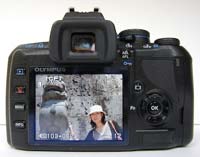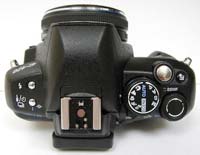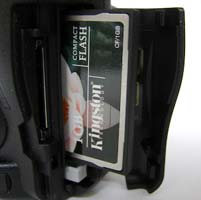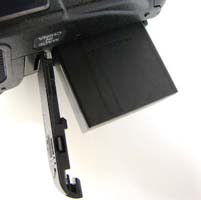Olympus E-420 Review
Review Date: June 5th 2008
Author: Gavin Stoker
Leave a comment about this Review
|
Introduction

The Olympus E-420 DSLR camera follows the recent trend of updating an existing design with a smattering of new features. Successor to the E-410, the new E420 model takes over the mantle as the World's most compact DSLR, weighing less than 400g and easily fitting into a small shoulder bag. The principal improvements include a larger 2.7-inch LCD screen, contrast detection autofocus and and face detection in Live View mode, and a slightly faster continuous shooting speed of 3.5 fps. The Olympus E-420 also boasts wireless flash control for studio shooting, Shadow Adjustment Technology, and Perfect Shot Preview for previewing camera adjustments before you take the photo. The core features remain the same as on the E-410 - a 10 megapixel Four Thirds standard Live MOS sensor, Supersonic Wave Filter for dust reduction, ISO 100 to 1600 and dual memory card slots for xD-Picture Card and CompactFlash. Accompanying the E-420 is an interesting new 25mm pancake lens, which provides a standard focal length of 50mm in 35mm terms. One big change is the price, with the E-420 being considerably cheaper at �379.99 / $599 (body only) than the E-410 was when it was launched just over a year ago. Gavin Stoker caught up with the new kid on the block to find out if the E420 is a worthy successor.
Compare Prices
Support PhotographyBLOG: Buy the Olympus E-420 from one of our affiliate retailers:Ease of Use
Olympus announced the entry-level E-420 Four Thirds system DSLR in conjunction with a Zuiko Digital 25mm 1:2.8 'pancake' lens equivalent to a 50mm on a 35mm model and has been sending that out with its review samples. While ideally suited for portraiture, the flagging up of new lens alongside camera raises the suspicion that there's no actually too much that's exciting about the 'new' E-420 � despite the new model's very competitive �330 body-only price point in the UK (by way of comparison the E-410 retailed for around �500 this time last year). Whilst it still offers a compact and lightweight chassis that's ideal for lugging the E-420 around abroad � and in fact I took the camera to Japan for the duration of our test where it nestled unobtrusively and comfortably in my shoulder bag � that alone wouldn't nudge me toward packing the camera in preference to say its direct competitors, the Canon's EOS-450D or Nikon's D60.
Though there are various under-the-bonnet performance tweaks which we'll come to later, it at first appears Olympus has rather taken a 'if it ain't broke, don't fix it' approach to this user-friendly upgrade � and is claiming anyone can be up and shooting with the camera without needing to crib from the manual. Just as well, as Olympus had neglected to include one with our review sample. For the record, like its E-410 predecessor you get continuous Live View on the LCD, which has increased in size from 2.5-inches to 2.7-inches and with the same 230k dot resolution, as one of the camera's specification highlights, aside from the now standard (at the entry-level) 10 effective megapixels resolution, the same again as that offered by the E-410. You also get 28 shooting modes in total while dual slots for both XD and Compactflash make a return, as does Olympus' grandly named Supersonic Wave Filter dust prevention system. Although this is active on start up, it thankfully doesn't noticeably delay proceedings and you can firing off your first image in just over a second which is fast enough for any consumer DSLR.
In maintaining compact dimensions the Olympus E-420 still lacks the more comfortable, larger rounded grip afforded its E-510/E-520 bigger brother/s. That said, a crowbar shaped raised ridge at the front feels more pronounced than its predecessor. When used in conjunction with the padded thumb rest at the rear, this meant the E-420 felt less like it was going to fly out of my hands on test. A look at the official spec however maintains the camera's overall dimensions are identical to its predecessor, but it does feel like there's more to get a grip on this time. Like both the E-400 and E-410 before it, the construction of the E-420 is better than you'd expect given the diminutive size, lightweight feel and its almost pocket-money price tag. The camera feels solid, less obviously plastic than many entry-level competitors, controls are clearly labeled and the size also helps them fall quickly to hand. The E-420 gives the reassuring impression from the off that this is a camera that will rise to the challenge of the photo enthusiast or family user on a budget.
So what further delights are to found lurking under the Olympus E-420's hood? A TruePic III image processor has enabled the implementation of shadow adjustment technology (SAT) that in practice provides much the same exposure-evening results as those from Nikon's own active D-Lighting function. It's basically a hassle-saver for beginners looking for more life-like results straight out of the camera. The processor has also allowed a slightly faster continuous capture rate � up to 3.5 frames per second from the E-410's 3fps � and at full resolution too, for, again, up to 8 Raw images or unlimited JPEGs. ISO meanwhile still ranges from ISO100 to a by current standards modest, noise-limiting ISO1600. For those occasions when you just want to point and shoot, auto focus has also been refined with the implementation of a new contrast AF system on top of phase detection AF, the full performance from which, suggest Olympus, can only be achieved with the following three lenses (though a firmware fix is downloadable for older optics).
 |
 |
| Front | Rear |
Aside from selling the Olympus E-420 with the 25mm lens for a total cost of �450 thereabouts, a further two kit options are available for those building a Four Thirds system from scratch. One option comes with the modest but more creatively flexible 14-42mm lens for �380 all-in. As we're talking a 3x zoom focus range, a better bet both creatively and financially would be to go for the �480 body plus twin lens kit � that adds a 40-150mm (80-300mm 35mm equiv.) optic � if you're considering buying into the E-420. We used a combination however of the new 25mm pancake and 14-42mm zoom for the duration of our test. With that in mind let's now take a tour of the E-420's layout, features and functions to see how they measure up to scrutiny, plus comparison with last year's E-410 model.
Viewing the camera from the front, little if anything has changed since the E-410, except for that aforementioned raised ridge to the left hand side that thankfully provides greater purchase for your fingers and allowing one handed operation at a push. The eyelets for the shoulder strap still feature rather inconveniently at the front rather than the sides, but again, given its size, this is a compromise users seemingly now have to come to terms with. Looking down on the camera next, and, as with the E-410, you're confronted with a busy looking top plate for such a compact camera. Helpfully raised most prominently, and also the largest control here, is the shooting mode wheel, encircled by an on/off switch. Flick the setting to on and you're ready to shoot in just over a second; the fact that dust reduction is active on start up perhaps slowing things down fractionally � but that won't be an issue for the consumer/family market at which the E-420 is primarily aimed. Blink again and you're already firing off the first shot, the E-420 as quick to find focus and determine exposure as hoped.
The mode dial at its centre meanwhile features the usual suspects of full auto, Program mode, Aperture Priority, Shutter Priority, Manual, plus the so-called 'easy shooting modes': scene mode, plus dedicated night portrait, sports, macro, landscape, and portrait settings, and these too remain unchanged from the E-410. Turning the mode dial to scene you get access to 18 pre-optimised settings. That's surprisingly two less than the E-410. As well as the common likes of landscapes, sunsets and fireworks, you get the family orientated likes of a setting specifically for children, plus more interesting high key or low -key options, though the underwater (wide) and underwater macro settings from the E-410 have mysteriously disappeared. Just forward and right of the mode wheel, and set at a slight angle, is the unmistakable shutter release button. It's responsive to the touch while the halfway point is easy to judge.
Immediately right of this again is a button for tweaking exposure compensation: give this a press with your forefinger and a simple numerical indicator appears in bright yellow top right of the LCD, rather than the slider graphic presented on the E-410. With a twist of the command dial the sits immediately behind the button, users have access to a wider than normal +/- 5EV adjustment range. As we noted at the time of reviewing the practically identically laid out E-410, the fact that these controls fall beneath finger and thumb without needing a second thought means the Olympus E-420 is intuitive to use, and its operation is fluid despite its busy appearance that also extends to the screen menus � more on which later. To the left of that main mode wheel is the hump that houses the built-in, springloaded pop-up flash, on top of � but set back from � which is a hot shoe for an additional flashgun.
 |
 |
| Pop-up Flash | Top Controls |
To the left of this again � still continuing to view the camera from the back � are two further standalone buttons. The one nearest to the user serves several functions: In playback mode, it's a copy button, a means of transferring images between memory cards � the Olympus E-420 as mentioned earlier again boasts two card slots, one for xD-Picture Card and the other for the more common CompactFlash. Secondly it's a means of earmarking individual or all images for print via a DPOF (Direct Print Order Format)-compatible printer. Thirdly, in shooting mode it's also a means of calling up the self-timer options on screen (again, either two or 12 seconds countdown), single or sequential frame capture (up to 3.5fps), while also providing the option for those who have purchased an additional remote control to capture a shot either straight away or after a two-second pause. Again, you can quickly access these options with a thumb turn of the command dial.
The second of the two buttons, just forward of the first, is marked with the familiar lightning bolt icon, and so activates the pop-up flash itself. Press this a second time in one of the creative shooting modes and the flash options appear on the rear LCD, which are more plentiful and varied than commonly found on entry level SLRs. Once again tabbing through the options with the single command dial, you get two slow sync modes, and not only auto red eye reduction but slow sync red eye reduction. In manual mode you can also control the output of the flash - from full power down to �, 1/16 or 1/64. This again is an identical set to that offered by last year's E-410.
And so to the back of the Olympus E-420, which is even more dominated by the LCD screen, it being fractionally larger than the E-410's at 2.7-inches. Briefly displaying a plethora of shooting info upon start up and again when the central 'OK' button on the camera back is pressed, the screen is reasonably clear when Live View is implemented via its dedicated button at the rear, displaying slight ghosting when panning indoors if we're being picky. The LCD features what Olympus is calling Perfect Shot Preview, which translates as the effects of exposure adjustment being able to be monitored using the rear screen, but this feels as it should be rather than something to get excited about In itself.
For the record the shooting information � displayed with a degree of transparency over the image if called up when Live View is active, which is a helpful touch � includes current ISO and white balance settings, flash mode, colour mode, shutter speed, aperture, metering, focus mode, single or sequential shooting, image quality setting � and even which of the two available card slots is currently in use. The layout is even busier looking than on the E-410 and if you want to recall this information later when not using Live View, a press of the dedicated info button at the bottom left of the screen does the job � otherwise pressing 'info' when in Live View brings up a live histogram.
 |
 |
| Memory Card Slot | Battery Compartment |
Above and ranged slightly to the right of the screen is the window for the optical viewfinder, surrounded for comfort by a rubber eyepiece. I wrote in my original review of the E-410 that the view through this could do with being both clearer and brighter, but the identical 95% coverage offered by the Olympus E-420 seems perfectly adequate in hindsight. Again there's an easily overlooked and quite stiff dioptric adjustment wheel to the right of the viewfinder for the myopic. Just below right of the viewfinder window is a dedicated Automatic Exposure Lock and Automatic Focus Lock button. The positioning of this also feels 'just right', as it too falls readily under the thumb as your finger quivers above the shutter release. And again this is identical to the control found on the E-410.
Just below, and to the right of the viewfinder is the aforementioned dedicated control marked with a screen icon that activates Live View. Whereas a year ago this function was a novelty on a DSLR it is now ubiquitous � and useful it is too at times to have not only have use of the monitor for composition but, when in manual mode, to enlarge the image on the screen up to 7x or 10x (you have to first press that info button again) to check you've got focus spot on before you take your shot. To the right and just below the Live View button is a familiar four-way controller for tabbing through menu screens and captured images, with a central 'OK' button for effecting changes. The left of the four controls on the Olympus E-420 is marked 'fn' for function. Press this when in Live View mode and key shooting settings pop up momentarily ranged to the right of the screen running from top to bottom. Another slight difference is a narrower rubber flap covering the combined USB and video out port that nestles directly below, though this appears purely a visual thing and doesn't affect overall performance in any way.
Swapping over to the left of the LCD now, we once again find the four self-explanatory buttons we found on the E-410. The top one is for playing back images, the second down is for deleting them, the third is the menu button for calling up self-same on screen and the last is the aforementioned 'info' control. Keeping things simple, whether in shooting or playback mode, a press of the menu button calls up five folders. The first folder features shooting settings such as image quality (we shot large, fine JPEGs for the purposes of our image samples) and picture modes � giving the choice of vivid, natural, muted colours or monotone � plus usefully, right at the top, the ability to format the card in use. This has stayed the same from the E-410 too.
Likewise has the second shooting folder which allows the selection of the likes of metering modes, plus AF mode selection, and an 'anti shock' function for situations where slow shutter speeds are used and camera vibration needs to be kept to a minimum. The third folder contains the standard playback options � including a doubling up of the DPOF faculty � while the fifth and sixth folders allow the fine tuning of a broad range of shooting and set up options to the nth degree � including the ability to fine tune the compression levels for the different resolution options. Generally, there's more control on offer here than you'd expect on a starter DSLR, never mind a professional model. The base of the E-420 meanwhile features the omnipresent screw thread for a tripod and a sliding door for the compartment that houses the rechargeable lithium-ion battery. That much is, once again, as expected.
So what now of the images the Olympus E-420 produces � are they a step on from the E-410 or another helping of the same?
|
![]() PhotographyBLOG
is a member of the DIWA
organisation. Our test results for the Olympus E-420 have been submitted to DIWA
for comparison with test results for different samples of
the same camera model supplied by other DIWA
member sites.
PhotographyBLOG
is a member of the DIWA
organisation. Our test results for the Olympus E-420 have been submitted to DIWA
for comparison with test results for different samples of
the same camera model supplied by other DIWA
member sites.
